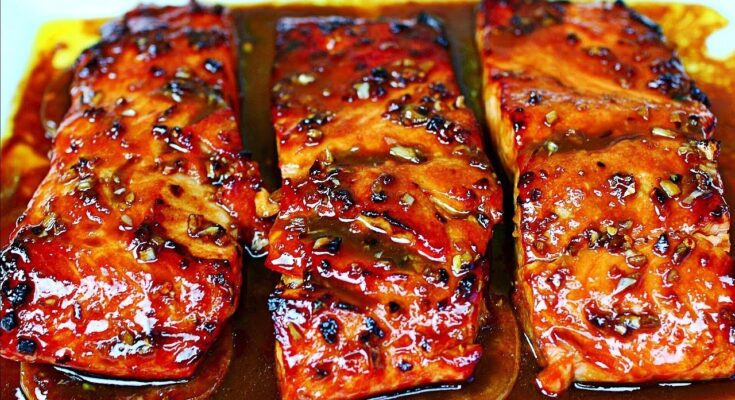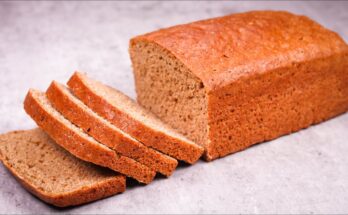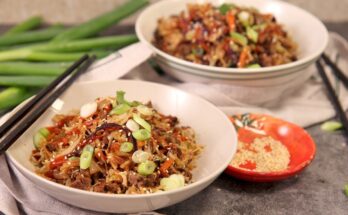Honey Garlic Salmon Recipe: There’s nothing quite like the combination of sweet honey, bold garlic, and tender, flaky salmon. If you’ve been searching for a quick yet flavorful dinner idea, this honey garlic salmon recipe is about to become your new favorite. It’s a dish that balances rich flavors with a touch of sweetness, making it appealing to both adults and kids alike. The beauty of this recipe is its simplicity—you don’t need to be a professional chef to get restaurant-quality results. With a few pantry staples, some fresh salmon, and less than 30 minutes of your time, you’ll have a dish that feels both fancy and comforting.
Salmon is often considered a tricky fish to cook because it can dry out if overcooked, but with the honey garlic glaze, it stays moist and flavorful. Whether you’re making it for a busy weeknight dinner or impressing guests at a dinner party, this recipe never fails to deliver. Plus, it pairs beautifully with a wide range of sides, from roasted vegetables and mashed potatoes to fluffy rice or even a crisp green salad.
This guide will walk you through everything you need to know: the ingredients, the step-by-step cooking process, tips to make it perfect every time, and even how to store leftovers (if you have any!). So, grab your apron and let’s dive into the delicious world of honey garlic salmon.
Why Honey Garlic Salmon is a Must-Try Dish
Some dishes become family favorites because they hit that perfect balance of taste, texture, and simplicity—and honey garlic salmon is definitely one of them. Unlike complicated seafood recipes that require hours of preparation, this one is quick, efficient, and foolproof. The rich taste of salmon pairs incredibly well with the sticky-sweet honey and aromatic garlic, creating layers of flavor in every bite.
One of the best things about this dish is its versatility. You can enjoy it with light sides like steamed vegetables if you want something healthy and low-carb, or go all out with creamy mashed potatoes or buttery pasta if you’re craving comfort food. It also works equally well for meal prep—cook a batch ahead of time, store it properly, and you’ll have delicious lunches ready for days.
If you’re someone who usually avoids cooking fish because it feels intimidating, honey garlic salmon will change your mind. With this step-by-step guide, you’ll see that cooking salmon at home is not only easy but also incredibly rewarding.
The Perfect Balance of Flavors
The magic of honey garlic salmon lies in its balance of flavors. The honey provides natural sweetness, which caramelizes beautifully when heated, giving the salmon a glossy, irresistible glaze. Garlic, on the other hand, brings depth and boldness, cutting through the sweetness and adding a savory punch. Together, they create a sauce that clings to the salmon and makes every bite memorable.
A hint of soy sauce or lemon juice (optional but highly recommended) adds acidity and umami, ensuring the dish doesn’t become overly sweet. The combination of sweet, savory, and slightly tangy flavors is what makes this recipe a standout. Think of it as the perfect marriage of simple ingredients working in harmony to create something extraordinary.
If you’ve ever felt that fish dishes are “boring,” this recipe will prove you wrong. Honey garlic salmon is the perfect example of how everyday ingredients can transform into something that tastes gourmet.
Ingredients You’ll Need
Core Ingredients for the Salmon
To make honey garlic salmon, you don’t need a laundry list of ingredients. The star of the dish is, of course, the salmon itself. Opt for fresh salmon fillets if possible, as they deliver the best texture and flavor. However, frozen fillets work just as well if thawed properly. Here’s what you’ll need for the base:
- Salmon fillets (skin-on or skinless, about 4–6 ounces each)
- Salt and pepper to season the fish before cooking
- Olive oil or butter for searing the salmon
When selecting salmon, you can choose between varieties like Atlantic, Coho, or Sockeye. Each has a slightly different flavor profile—Atlantic salmon is milder, while Sockeye is richer and more robust. Skin-on fillets are great because the skin helps hold the fish together during cooking and adds a nice crispy texture when seared.
Essential Pantry Items for the Sauce
The real star of this dish is the honey garlic sauce. It’s a sticky, golden glaze that elevates the salmon from simple to spectacular. For this, you’ll need:
- Honey – for sweetness and caramelization
- Garlic – fresh cloves, finely minced for maximum flavor
- Soy sauce – adds umami depth and balances sweetness
- Lemon juice (or lime juice) – optional, but gives brightness and acidity
Together, these ingredients create a sauce that’s both sweet and savory, with a little tang to keep things balanced. You probably already have most of them sitting in your kitchen right now.
Optional Add-Ons for Extra Flavor
While the basic recipe is delicious on its own, you can easily customize it to suit your taste preferences. Some great additions include:
- Red pepper flakes or chili paste – for a spicy kick
- Ginger – grated fresh ginger adds warmth and zing
- Sesame seeds – sprinkled on top for crunch and nuttiness
- Fresh herbs – parsley, cilantro, or green onions for garnish
These optional extras aren’t required but can help you tailor the dish to your mood. For example, if you’re making this dish for kids, you might skip the chili flakes, but if you want to impress guests, adding sesame seeds and herbs makes it look extra fancy.
Step-by-Step Guide to Cooking Honey Garlic Salmon
Step 1 – Preparing the Salmon Fillets
Begin by patting the salmon fillets dry with paper towels to remove excess moisture—this helps them sear beautifully. Season lightly with salt and pepper on both sides. If you like a touch of extra flavor, add a pinch of paprika or chili flakes for a subtle kick.
Step 2 – Mixing the Honey Garlic Sauce
In a small bowl, whisk together honey, minced garlic, soy sauce, and a squeeze of fresh lemon juice. This simple sauce balances sweetness, savoriness, and tang, making it the star of the dish. Set it aside for glazing the salmon.
Step 3 – Pan-Seared Perfection
Heat a tablespoon of olive oil or butter in a skillet over medium-high heat. Place the salmon fillets skin-side down and cook for 3–4 minutes until golden and crisp. Flip carefully and cook the other side for another 2–3 minutes, depending on thickness. The salmon should be nearly cooked through but still tender.
Step 4 – Glazing with Sauce
Reduce the heat to medium-low, then pour the honey garlic sauce into the skillet. Let it simmer for a minute, spooning the glaze over the salmon as it thickens. The sauce will caramelize slightly, coating the fillets in a glossy, flavorful finish.
Step 5 – Serving Suggestions
Serve the honey garlic salmon hot, drizzled with extra sauce from the pan. Pair it with steamed rice, roasted vegetables, or a light salad for a complete meal. Garnish with fresh parsley or sesame seeds for a touch of color and freshness.
Tips and Tricks for the Best Honey Garlic Salmon
How to Prevent Overcooking
One of the biggest challenges when cooking salmon is avoiding overcooking. Salmon cooks faster than most meats, and a few extra minutes in the pan can mean the difference between juicy, tender fillets and dry, tough fish. To prevent this, always cook salmon over medium-high heat first to sear, then reduce to medium or medium-low to finish cooking. A good rule of thumb is to cook salmon for about 4–6 minutes per half-inch of thickness.
If you want a foolproof way to check doneness, use a meat thermometer. Perfect salmon should reach an internal temperature of 125–130°F (52–54°C) for medium-rare or 135–140°F (57–60°C) for medium. Remember, the salmon will continue to cook for a minute or two after you remove it from the heat, so it’s better to pull it off slightly earlier than too late.
Another trick is to look at the color change on the sides of the fillet as it cooks. Raw salmon is bright and translucent, while cooked salmon becomes opaque and lighter in color. Watching that transition can help you know when to flip or finish cooking.
Making the Sauce Stick Better
A common mistake is adding the sauce too early, which can cause it to burn before the salmon is done. The trick is to sear the salmon almost fully before pouring in the sauce. Once the sauce is added, reduce the heat and let it thicken into a glaze while you spoon it over the salmon.
If your sauce feels too runny, let it simmer for a few extra minutes. The natural sugars in the honey will thicken it up nicely. On the other hand, if it gets too thick, simply add a splash of water or broth to loosen it without losing flavor.
A great hack to help the sauce stick is lightly dredging the salmon in flour before searing. This creates a delicate crust that holds onto the glaze beautifully. It’s not necessary, but it’s a restaurant-style upgrade if you want extra wow factor.
Pairing Ideas with Honey Garlic Salmon
This dish is already a star on its own, but the right side dishes can elevate your meal to a whole new level. Since honey garlic salmon has bold and slightly sweet flavors, pair it with sides that balance or complement those notes.
Here are some winning pairings:
- Light & Fresh: Steamed green beans, roasted asparagus, or a cucumber salad with lemon vinaigrette.
- Comforting & Hearty: Garlic mashed potatoes, buttery noodles, or creamy risotto.
- Nutty & Earthy: Wild rice pilaf, roasted sweet potatoes, or quinoa salad with cranberries and nuts.
- Refreshing & Citrusy: A citrus avocado salad, lemon-dressed kale, or grilled zucchini with lime.
When it comes to drinks, white wines like Sauvignon Blanc or Chardonnay pair beautifully, while sparkling water with lemon is a refreshing non-alcoholic option. If you want to go bold, try pairing with a light beer or even ginger ale for a fun twist.
Nutritional Benefits of Honey Garlic Salmon
Health Benefits of Salmon
Salmon isn’t just delicious—it’s also packed with nutrients that make it one of the healthiest proteins you can eat. A single serving of salmon is rich in omega-3 fatty acids, which are essential for heart health, brain function, and reducing inflammation. These healthy fats can help lower cholesterol levels, improve memory, and even boost your mood.
Beyond omega-3s, salmon is an excellent source of high-quality protein, which your body needs for muscle repair, immune function, and overall energy. It also provides essential vitamins like vitamin D (important for bone health), vitamin B12 (crucial for energy and brain health), and selenium (a powerful antioxidant).
Eating salmon regularly has been linked to a reduced risk of heart disease, improved joint health, and even healthier skin. It’s one of those foods that truly earns the label “superfood.”
Nutritional Power of Garlic and Honey
While salmon steals the spotlight, the honey garlic sauce adds its own nutritional perks. Garlic has been used for centuries not just as a flavor enhancer but also as a natural medicine. It contains compounds like allicin that support heart health, lower blood pressure, and even boost immunity. Garlic is also known for its antibacterial and anti-inflammatory properties, making it a small but mighty ingredient.
Honey, on the other hand, is a natural sweetener that brings more than just flavor to the dish. Unlike refined sugar, honey contains antioxidants, enzymes, and trace minerals. It provides quick energy while also offering antimicrobial properties that can soothe sore throats and support digestion.
Together, garlic and honey not only make your salmon taste amazing but also turn the dish into a nutrient-rich meal that supports your overall health.
Storage and Reheating Instructions
How to Store Leftovers Properly
If you’re lucky enough to have leftovers, honey garlic salmon stores surprisingly well. Allow the salmon to cool completely before storing, but don’t leave it out for more than two hours at room temperature. Once cooled, place the fillets in an airtight container and refrigerate. They’ll stay fresh for up to 3 days.
For longer storage, you can also freeze salmon. Wrap each fillet tightly in plastic wrap or foil, then place them in a freezer-safe bag. Frozen salmon will keep for about 2 months. When ready to eat, thaw it overnight in the refrigerator for the best texture.
Pro tip: If you’re meal prepping, store the salmon separately from any sides. This prevents the glaze from making rice or veggies soggy.
Best Ways to Reheat Without Drying
Reheating salmon can be tricky—done wrong, it becomes dry and tough. The best method is to reheat it gently in the oven. Preheat your oven to 275°F (135°C), place the salmon on a baking sheet, and warm for about 10–15 minutes. This keeps the fish moist and flavorful.
Another great option is using a skillet. Heat a nonstick pan over low heat, add a splash of water or broth, and cover with a lid. This creates steam that reheats the salmon while keeping it tender.
Avoid the microwave if possible, as it tends to dry out the salmon and make the sauce rubbery. But if you’re short on time, reheat in 30-second intervals with a damp paper towel over the salmon to trap moisture.
Common Mistakes to Avoid When Cooking Salmon
Overcrowding the Pan
One of the most common mistakes home cooks make is overcrowding the pan. When too many salmon fillets are packed tightly together, they steam instead of sear. This prevents that beautiful golden crust from forming and leaves you with soft, soggy fish instead of crispy edges.
The solution? Give your salmon some breathing room. Use a large skillet, or cook in batches if necessary. Each fillet should have enough space around it so the hot oil can circulate freely. If you’re preparing salmon for a big family dinner, resist the temptation to squeeze them all into one pan. Taking a few extra minutes to cook in batches will make a huge difference in flavor and texture.
Another tip is to avoid flipping too often. Let the salmon cook undisturbed for a few minutes before turning it over. This allows the surface to caramelize and release naturally from the pan. If it sticks, it’s not ready to flip yet. Patience pays off when it comes to pan-searing.
Using Too Much Sauce
While the honey garlic glaze is the star of this recipe, too much of it can overwhelm the salmon. Remember, the sauce is meant to enhance the fish—not drown it. Adding too much sauce too early can also cause it to burn, leaving a bitter taste.
The best method is to add the sauce after the salmon has been seared. This way, it caramelizes gently and sticks beautifully to the fillets. If you love having extra sauce for rice or veggies, make a double batch separately. Cook half of it with the salmon for flavor, and reserve the other half for drizzling at the table.
This approach ensures your salmon gets that perfect glossy coating without overpowering its natural flavor. Balance is key—the sweetness of honey and the boldness of garlic should complement the salmon’s richness, not mask it.
Skipping the Resting Step
Just like steak or chicken, salmon benefits from a brief resting period after cooking. Skipping this step is a mistake that can cost you flavor and texture. When salmon cooks, the juices move toward the surface. If you cut into it immediately, those juices will run out, leaving the fish drier.
Let the salmon rest for about 3–5 minutes after cooking. Cover it loosely with foil to keep it warm while the juices redistribute evenly. This simple step makes a big difference, ensuring every bite is moist and flavorful.
It’s tempting to dive right in when the kitchen smells like heaven, but trust me—waiting just a few minutes rewards you with the perfect salmon experience.
FAQs about Honey Garlic Salmon Recipe
1. Can I make honey garlic salmon ahead of time?
Yes, but it’s best fresh. If meal prepping, store the sauce separately and add it when reheating to keep the glaze glossy.
2. What’s the best pan for cooking salmon?
A heavy nonstick skillet or cast-iron pan works best. They retain heat well and help achieve that golden crust.
3. Can I grill honey garlic salmon?
Definitely! Grill the salmon skin-side down first, then brush with the sauce during the last few minutes of cooking to prevent burning.
4. How can I tell if my salmon is cooked?
The salmon should flake easily with a fork and look opaque in the center. For accuracy, check with a meat thermometer.
5. Can I use frozen salmon without thawing?
It’s better to thaw salmon before cooking for even results. Cooking from frozen often leads to uneven texture.
Conclusion
Whether you pan-sear it for that golden crust or bake it for convenience, this recipe never disappoints. Plus, it’s customizable—make it spicy, add ginger for zing, or garnish with sesame seeds for a nutty crunch. Paired with rice, veggies, or salad, honey garlic salmon is a meal you’ll want to make again and again.
Cooking salmon doesn’t have to be intimidating. With the right tips—like not overcrowding the pan, balancing the sauce, and letting the fish rest—you’ll nail it every time. And the best part? You don’t need fancy ingredients or hours in the kitchen. Just simple steps, wholesome ingredients, and a little love.
So next time you’re wondering what to cook for dinner, give this honey garlic salmon recipe a try. Your taste buds (and your family) will thank you!



